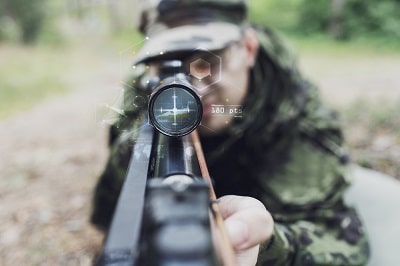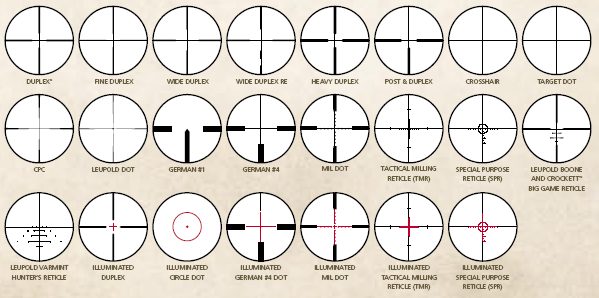To the beginner, rifle reticles can be a bit overwhelming. wondering how to make sense of rifle scope reticles? In this article, we will go over some of the basics to give you an understanding about scopes in general.
There is a lot of terminology used that can be quite confusing, and the different types of reticles and scopes can be confusing as well.

Basic reticle scope
Wondering how to make sense of rifle scope reticles? In this article, we will go over some of the basics to give you an understanding about scopes in general.
The Basic Types of Reticles
For starters, a reticle is the aiming point of a scope. In simpler terms, it’s the “crosshairs” if you will. It is the internal part of the scope that you use to aim where you want to shoot.
The crosshair reticle is exactly what it sounds like. It has thin lines that meet in the center. That center is what you use as your aiming point.
However, there are crosshair style reticles that have thicker lines. Some of these are called duplex reticles and German numbered reticles.

Scope Reticles Type
1. What is a BDC Reticle?
A BDC reticle is generally a modified crosshair or duplex style reticle. BDC stands for bullet drop compensating.
Basically, it is a reticle that has some type of markings below the center of the crosshairs that you can use to anticipate bullet drop over an extended range.
A BDC reticle is generally a crosshair or duplex style reticle that has some dots or markings below the center.
If you are finding BDC reticle scope for ar10, check this post about best AR-10 scope, it will helpful
2. The Mildot Reticle
Another modified crosshair or duplex style reticle is the mildot reticle.
A mildot reticle is a reticle that uses tiny milradian dots on both axes of the crosshairs as a measurement.
A mildot reticle allows you to find the approximate distance your target is at. The math behind it can be pretty confusing, but that’s what it boils down to.
3. A Dot Reticle
A dot reticle is something you might find in a tactical style “red dot sight.” It uses one dot in the scope as the aiming point.
Generally speaking, they are illuminated.
4. The Illuminated Reticle
Illuminated reticle refers to a reticle that has some type of light.
Whether it’s a battery-operated dot or a fiber optic scope, it is some type of illumination that will allow you to see better at night.
However, certain colors also help to see during the day.
Keep in mind that many of these reticles can overlap one another. For example, there could be an illuminated duplex BDC reticle, which would combine a few of these basic categories.
When Should I Use Each Type of Reticle?
That may have been a lot to take in. I’m sure you’re wondering in which shooting situations each reticle type would be best.
For any kind of precision shooting, you really want a thin crosshair style reticle.
The thin crosshair is paramount because the smaller the reticle is, the less amount of target surface area that is covered by the reticle.
When you are attempting any type of shooting that requires extreme accuracy, you want to be able to see as much of the target as possible.
What type of Reticle For hunting:
Duplex style reticles are very popular.
The reason behind this is that the wider legs of the crosshair allow the hunter to easily acquire a target and get his reticle centered on target faster.
For Long Range Hunting
BDC reticles are popular for long range hunting. However, dependent on the type of hunting, a thin crosshair may also be good for long range hunting. For any type of long range shooting, BDC reticles are a decent option.
For Snipner Shooting or Tatical Use
For any kind of sniper shooting or tactical use, mildot reticles are popular. However, for the common person, the math and adjustments that go into a mildot reticle can be a little confusing, and are probably a little overkill.
Obviously any kind of shooting or hunting at night would make an illuminated reticle very important. However, it is worth mentioning that a low quality illuminated reticle will be way too bright, making it difficult to acquire your target.
Conclusion
As you can see, there are quite a few different kinds of reticles, each of which comes with their own pros and cons.
There are quite a few factors to consider, but hopefully this basic overview has cleared up some of the confusion with the different types of reticles.
Essentially, when you need extremely accurate shots, a thin crosshair is in your best interest.
For hunting, a wider duplex reticle will make it easier and faster to acquire your targets.
At long distances, a BDC or mildot reticle can help to adjust your shots.
When shooting at night, an illuminated reticle would be extremely helpful.
Other than that, there are many different combinations of reticles available, so you should be able to fill more than one need with a single scope. Dot sights are becoming more and more popular, for all different kinds of shooting.
Keeping these basics in mind will help to clear up some of the confusion.
Nice article very informative. Could you do an MOA reticle paragraph please.